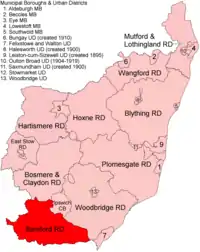Samford Rural District
Samford Rural District was a rural district within the administrative county of East Suffolk between 1894 and 1974. It was created out of the earlier Samford rural sanitary district.[1]
| Samford | |
|---|---|
 Location within East Suffolk, 1894 | |
| History | |
| • Created | 1894 |
| • Abolished | 1974 |
| • Succeeded by | Babergh |
| Status | Rural district |
Under the East Suffolk County Review Order of 1934, the only changes made were a revision of the boundary with the county borough of Ipswich. This boundary was revised again in 1952.
Under the Local Government Act 1972, Samford Rural District was abolished in 1974, and its area became part of the district of Babergh.
Statistics
| Year | Area[2] | Population [3] |
Density (pop/ha) | |
|---|---|---|---|---|
| acres | ha | |||
| 1911 | 45,347 | 18,351 | 13,868 | 0.76 |
| 1921 | 14,640 | 0.80 | ||
| 1931 | 13,931 | 0.76 | ||
| 1951 | 45,139 | 18,267 | 15,324 | 0.84 |
| 1961 | 45,030 | 18,223 | 14,509 | 0.80 |
Parishes
Samford RD contained the parishes of Belstead, Bentley, Brantham, Burstall, Capel St Mary, Chattisham, Chelmondiston, Copdock, East Bergholt, Erwarton, Freston, Great Wenham, Harkstead, Higham, Hintlesham, Holbrook, Holton St Mary, Little Wenham, Raydon, Shelley, Shotley, Sproughton, Stratford St Mary, Stutton, Tattingstone, Washbrook, Wherstead and Woolverstone.
References
- "Samford RD through time: Census tables with data for the Local Government District". A Vision of Britain through Time. GB Historical GIS / University of Portsmouth. Retrieved 10 July 2017.
- "Samford RD through time: Population Statistics: Area (acres)". A Vision of Britain through Time. GB Historical GIS / University of Portsmouth. Retrieved 10 July 2017.
- "Samford RD through time: Population Statistics: Total Population". A Vision of Britain through Time. GB Historical GIS / University of Portsmouth. Retrieved 10 July 2017.